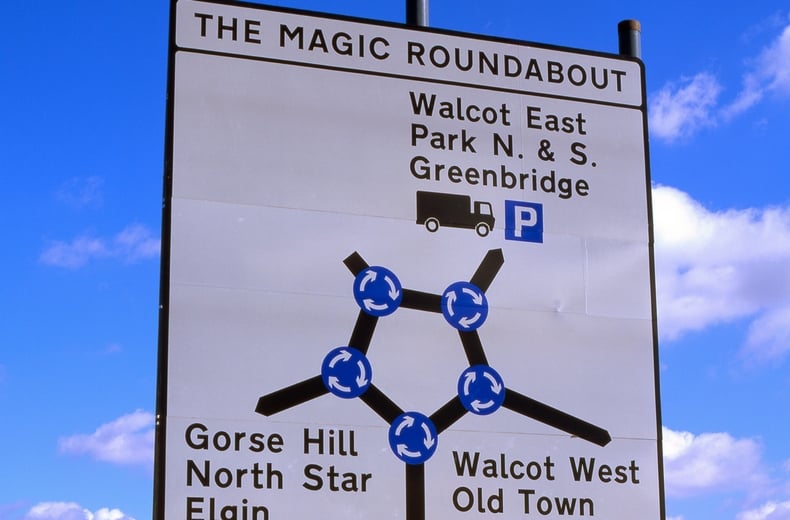But with experience and the right know-how, using the circular junctions soon becomes second nature.
Here, we'll cover everything you know to become a roundabout-pro.
Why do we have roundabouts?
When two, or more, busy roads intersect – something has to give.
Roundabouts are designed to keep traffic moving, ease congestion and speed up journey times.
They’re also safer than traditional junctions and crossroads – where drivers can be tempted to run red lights. On roundabouts traffic always travels in the same direction, making manoeuvres like right turns far easier.
Black Box Insurance
Want to pay less for your car insurance? Whether you’re a new driver or just looking to reduce costs, we can help.


How do roundabouts work?

The approaching traffic usually gives way to traffic already on the roundabout, which always comes from the right.
By waiting for a safe gap – you can join the flow of traffic and continue in the correct lane until reaching your exit.
Ensure that you signal before you leave the roundabout. You would usually signal as you pass the exit just before the one you need.
It’s also possible and recommended to use a roundabout to perform a U-turn. This is the safest option.
Like regular roads, larger roundabouts consist of different lanes. Only by joining a roundabout in the correct lane will you be able to access your chosen exit.
A typical roundabout has three or four exits, although in some cases there can be as many as seven, or as few as two.
Need to bring down new-driver insurance costs? Have you heard of black box insurance?
Approaching a roundabout and picking the correct lane
You’ll know you’re approaching a roundabout when you see a red triangle warning sign with a black circular emblem inside. However not all roundabouts are signposted.
Mini-roundabouts, will usually be flanked with a blue circle sign with three white circular arrows inside.
Need help passing your theory test? Find everything you need with the driving theory test app
Mini roundabouts work in the same way as larger ones, but often appear in narrower residential areas.
Once you’ve identified a roundabout ahead, it’s time to start making your preparations and crucially select the correct lane.
Road markings in the form of arrows (and often text), work together with road signs on the roundabout approach to indicate which lanes go where on each specific roundabout.
But you’ll soon get into the habit of selecting the lane you’ll need, and in some cases you’ll even have a choice.
Once you’ve reached the roundabout and decided whether you need to stop or whether you can continue if the road is clear then select the correct gear.
Now it’s time to acknowledge the golden rule of roundabouts:
Give way to traffic coming from the right.
Ensure you’re signalling in the direction you want to take before entering the roundabout, unless you’re travelling straight on, in which case you don’t need to signal until you pass the exit before the one you are going to use.
If the roundabout has standing traffic, you can only join it if you will not block any entrances or exits.
- How to get a provisional driving licence
- Did you know that we offer specialist learner driver insurance?
- A guide to overtaking safely on the road
Turning left
If you’re taking a left turn at a roundabout (usually the 1st exit), you’ll always need to approach it in the left lane.
Ensure you remain in the left-hand lane for the entire time you’re on the roundabout. Keep your left indicator on and leave via the first exit.
Continuing straight ahead
Often, you, just want to travel straight on through the roundabout, sometimes people will say: 'head straight over the roundabout'.
Depending on the size of the roundabout, you’ll often be able to use the left-hand lane for this, but in some cases the left-hand lane will be for left turns only (signs will guide you on this).
There are also instances where larger roundabouts, have a designated lane for driving straight over. Check the road markings on approach.
Just after the first exit, check your main mirror, then your left door mirror. Signal left and if all is clear, take your exit.
Turning right
If you’re taking a right turn at a roundabout, (typically the 3rd exit), you’ll need to travel around it from the right-hand lane.
Continue in the right-hand lane until you pass the 2nd exit. Check your main mirror, then your left door mirror and signal left.
You’ll need to move into the left lane before exiting – so check your blind spot while doing this with a quick glance over your left shoulder. Once in the left lane you’re ready to exit.
READ MORE: Stopping distances made simple
MORE ADVICE: What is a driving test fail? Majors and minors explained
Mirror
First check your centre mirror, then the relevant door mirror. If planning to turn left then check the left door mirror and if turning right then check the right door mirror.
Assess the space around you and identify where you may have to move.
In your driving test, an examiner will want to clearly see you’re checking your mirrors when necessary.Some people find it helpful to audibly convey they are checking their mirrors by saying ‘mirrors’ as they do so, to really hammer home to the examiner that you are carrying out the checks.
Signal
If changing lanes on approach to the roundabout, signal as soon as possible after checking your mirrors.
As you approach the roundabout, signal your direction of travel unless proceeding straight ahead.
Position
Roundabout exits will usually be detailed on a road sign on your approach, while road markings will make it clear which lane you need to be travelling in.
Speed
All roundabouts offer different levels of visibility, which can affect your approach speed. You may need to slow down –sometimes to a complete stop – before joining a roundabout.
Look
You should not join a roundabout without looking both ahead, and to your right-hand side – although how soon in advance you can do this depends on your view as you approach. You may have traffic in the lane to your right which obstructs your view.A ‘closed’ roundabout may offer no visibility of oncoming traffic until the last minute, while a more ‘open’ set-up means you can see all around you on approach and can assess the situation in advance.
How could I fail my test at a roundabout?
Here we take a look at potential mistakes you could make on your driving test and whether they will constitute a fail or not.
You can have up to 15 driver faults but just one serious fault means a fail.
Hesitating at a roundabout
Of course you won’t be penalised for ‘not taking a chance’, and nobody wants you to take risks, but if you miss a clear-cut, safe opportunity to join a roundabout, you’ll be holding up traffic for no good reason.
A short delay may be marked as a driver fault. If you miss a clear opportunity where there was plenty of time to proceed you may fail the test as a serious fault could be marked.
If it’s clear early on that you’re fine to continue, do so without stopping completely – which could cause a rear-end collision
Failure to safely address a wrong lane choice
You won’t fail your test for choosing the wrong lane – it’s all about how you react. Use mirrors, checks, speed and signals to get back on track and you’ll be fine.
Driving straight over the centre of a mini-roundabout
While clipping the painted, or raised centre is unlikely to result in a failure, blatantly driving over it will.
Failure to signal
Particularly if cutting across lanes to exit on a right turn, you’ll be heavily penalised for not signalling as this is a very risky manoeuvre.
Forgetting to cancel the indicator after exiting
If you leave your signal on for too long it will confuse other road users. Whether this is classed a driver fault or a serious fault will depend on how long it is before you notice!
READ NEXT: How to pass your driving test – a full guide from novice to pro

Learner Driver Car Insurance
Only pay for the cover you need until you’ve passed your test. Get learner driver insurance so you can practice outside of your lessons.




















